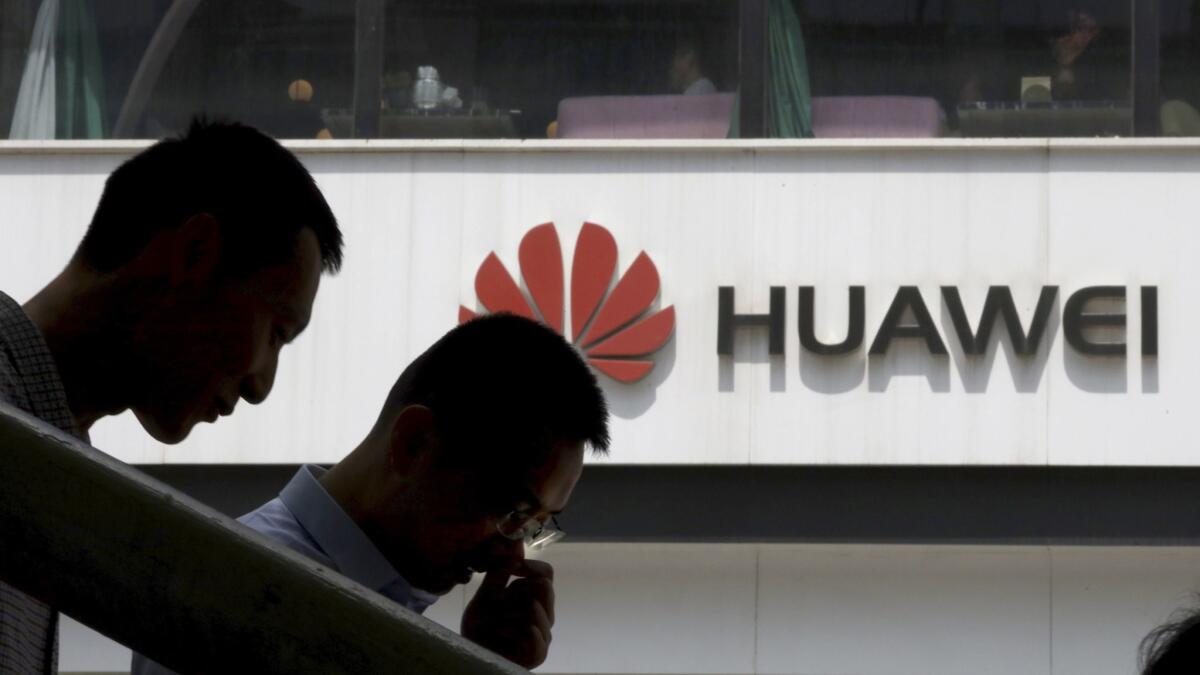Huawei personnel worked with China’s military on research projects

- Share via
Several Huawei Technologies Co. employees have collaborated on research projects with Chinese armed forces personnel, indicating closer ties to the country’s military than previously acknowledged by the smartphone and networking powerhouse.
Over the last decade, Huawei workers have teamed with members of various organs of the People’s Liberation Army on at least 10 research endeavors including artificial intelligence and radio communications. They include a joint effort with the investigative branch of the Central Military Commission — the armed forces’ supreme body — to extract and classify emotions in online video comments, and an initiative with the elite National University of Defense Technology to explore ways of collecting and analyzing satellite images and geographical coordinates.
Those projects are just a few of the publicly disclosed studies that shed light on how staff at China’s largest tech company teamed with the People’s Liberation Army on research into an array of potential military and security applications. Bloomberg culled the papers from published periodicals and online research databases used mainly by Chinese academics and industry specialists. The authors of the treatises, which haven’t been reported in the media previously, identified themselves as Huawei employees, and the company name was prominently listed at the top of the papers.
“Huawei is not aware of its employees publishing research papers in their individual capacity,” spokesman Glenn Schloss said in a statement. “Huawei does not have any R&D collaboration or partnerships with the PLA-affiliated institutions,” he said. “Huawei only develops and produces communications products that confirm to civil standards worldwide, and does not customize R&D products for the military.”
China’s defense ministry didn’t respond to a faxed request for comment.
The Trump administration has imposed strict limits on Huawei’s ability to do business with U.S. companies and has urged allies to follow suit, saying it poses a national security threat. Washington has zeroed in on what it says is Huawei’s close association with the armed forces in part because billionaire founder Ren Zhengfei — a self-avowed Communist Party loyalist — was an officer who worked on communications during his military tenure.
It’s unclear whether the studies Bloomberg saw — dating to 2006 and discovered during a search of an online database used in part by professors to root out plagiarism among college students — encompassed every instance of Huawei-employee collaboration with the People’s Liberation Army. Many sensitive projects are classified or just never make it online. Although researchers with both Huawei and the military published thousands of papers, according to that database, only the 10 Bloomberg saw were joint efforts. And the company employs more than 180,000 people.
Tech companies and military agencies have been collaborating around the world for decades, generating many of the technologies that underpin the modern internet. In China, that public-private relationship is particularly close-knit because of the Chinese government’s sway in every sector of the economy. But Huawei consistently plays down suggestions that Ren’s background influences the corporation in any way, and it says its relationship with the military is minimal and nonpolitical.
The research papers show one area of overlap, at least in terms of personnel. Although they don’t prove Huawei itself has close links to the Chinese military, they do show that the company’s relationship — or at least that of its employees — with the People’s Liberation Army is more nuanced than its executives have previously outlined publicly.
Huawei has said it never discloses sensitive information to the government and wouldn’t even if asked. Ren himself has shrugged off Huawei’s relationship with the military since he emerged from semi-seclusion in January to speak with foreign media for the first time in years.
“We have no cooperation with the military on research,” he told reporters in Shenzhen in January, according to a transcript that Huawei provided. “Perhaps we sell them a small amount of civilian equipment. Just how much, I’m not clear on because we don’t regard them as a core customer.”
The armed forces, too, have strongly denied official links to Huawei. “Huawei is not a military company,” Defense Minister Gen. Wei Fenghe said at the Shangri-La Dialogue in Singapore this month. “Do not think that because the head of Huawei used to serve in the military, then the company that he built is part of the military.”
Yet the extent of Huawei’s military ties remains a topic of intense scrutiny in the United States because of the role the People’s Liberation Army has had in a variety of issues, including ratcheting up tensions in the South China Sea and alleged acts of state-sponsored hacking. Its opaque operations and far-reaching powers in a country obsessed with stability have also raised concerns. Chairmanship of the Central Military Commission is often thought to be key to maintaining power in the country, which is why Chinese President Xi Jinping and his predecessors were appointed heads of the body. Xi has doubled down on a policy dubbed “civil-military integration,” which aims to harness technology for military purposes. Beijing has thus encouraged greater participation from private companies in the defense sector.
Bloomberg was unable to contact the employees listed or determine whether they remain at the company.
The online sentiment classification study, which lists Shanghai-based Huawei employee Li Hui as its lead author — focused on video and improving the accuracy of natural language processing algorithms. It yielded “very high accuracy,” according to a paper published in the May 2019 edition of Netinfo Security, a journal owned by a research institute of the Ministry of Public Security. Researchers used 240,000 comments to train their AI algorithms before testing them on a data pool of a million entries.
Li identified his or her employer as Shanghai Huawei Technology Co. The three co-researchers listed on the paper hailed from the People’s Liberation Army’s central committee, an elite IT research lab and another military unit, the paper showed. The project was funded by the National 242 Information Security Project, a program created by the Chinese government to support IT security research efforts.
Wong Kam Fai, a Chinese University of Hong Kong professor who studies natural language processing, said that it’s common that universities in China and companies would collaborate with the government or military. Chinese “universities are quite open to working with the military. If it’s very sensitive, it will be classified.”
Wong said the papers on using technology to detect emotions in videos weren’t particularly cutting edge, which partly explains why they can be made public. “Different projects have different sensitivity levels, and sometimes the government will own the [intellectual property],” he added. “It’s possible that there’s a lot of research that people are just not seeing, because some military research is sensitive and classified.”
In addition, researchers sometimes put their employer’s name on papers without notifying the company, or wait till the paper comes out before doing so. That’s because some papers never get published.
The author of a 2006 paper on America’s combat network radio — Zheng Chuangming, from the Shenzhen Huawei Base — looked into how U.S. software algorithms helped boost efficiency and conserve power. Zheng had published a more general paper on the same system months earlier but listed his affiliation on that earlier document as the state-owned 7th Research Institute of China Electronics Group Corporation.
Another Huawei employee, Li Jie, is listed as working with two military researchers on the genesis and outlook of the geographical information system, used to collate and parse location data. That’s according to a study included in papers published after an academic seminar on telecommunications in the northern city of Dalian in 2009. It’s not clear if Li, who worked in the Foundation Department of Huawei Technologies Co., remains with the company. One of his co-researchers came from the National University of Defense Technology, one of the country’s best military academies. A third author was from a People’s Liberation Army entity that only showed up as a unit designation, according to publicly available information.
And in yet another paper published in 2013, Huawei employee Zhou Jian worked with a People’s Liberation Army hospital on ways to help doctors better detect heart signals. The study was funded by the military’s 12th Five Year project, according to an introduction to the paper posted on cnki.cn, an online archive of academic research papers. Zhou is identified as an employee of Huawei Technologies Co.
“In the U.S. they have similar arrangements as well. The U.S. has military grants,” Wong said. “There are many sources of funding, including from the military for research.”
More to Read
Inside the business of entertainment
The Wide Shot brings you news, analysis and insights on everything from streaming wars to production — and what it all means for the future.
You may occasionally receive promotional content from the Los Angeles Times.










